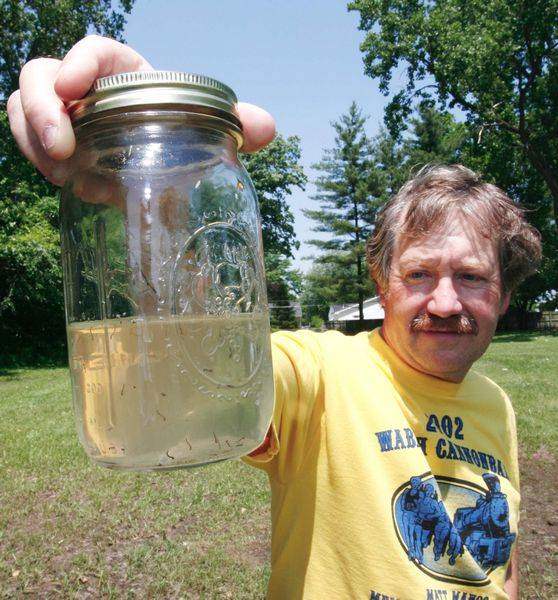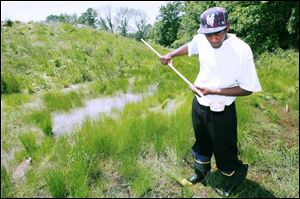
Mosquito team is doing battle with summertime pest
6/8/2007
Biologist Lee Mitchell eyes a jar of water containing mosquito larvae that was scooped up near Start High School. Mr. Mitchell says the mosquito crop is early this year.

Biologist Lee Mitchell eyes a jar of water containing mosquito larvae that was scooped up near Start High School. Mr. Mitchell says the mosquito crop is early this year.
Pesky blood-sucking mosquitoes are back in droves after several months of wacky weather - and so is nighttime spraying.
While the threat of West Nile virus spread to humans through mosquitoes usually doesn't surface until at least July, the Toledo Area Sanitary District likely will begin sending insects to a state lab for testing next week, said Lee Mitchell, a district biologist.
Lucas County had six cases of West Nile virus in humans last year, which Mr. Mitchell called an inexcusable number.
"Our business is not to just have one or two or three or four," Mr. Mitchell said. "We don't want to have any."
The county's first human case of West Nile virus was reported on Sept. 17, 2002, and there were a dozen cases that year, according to the Toledo-Lucas County Health Department. Michigan and Ohio, respectively, had the second-highest and third-highest number of West Nile virus cases nationwide that year - a combined total of 1,055, a number that has since plunged, dropping to 103 last year.
Mosquitoes, however, have been abundant so far this year in Lucas County after warm spells in February and March were followed by melting snow and wet weather, Mr. Mitchell said. Adult mosquitoes started appearing in Lucas County the second week of May, a little earlier than normal despite district efforts since mid March to kill larvae in standing water where breeding occurs, he said.
"We're looking now for some dry weather," he said. "It's been a very active spring this year."

Terrence Autman of the sanitary district looks for mosquito larvae near Start High School. The threat of West Nile disease has increased mosquito control efforts in recent years.
Nighttime spraying began in the western part of the county Monday and is moving east through suburban Toledo, Mr. Mitchell said. The district has been fielding about 150 calls a day with requests for spot spraying, too, and continues to treat standing water with a bacterial product, he said.
Last year also was a tough mosquito year, and the district used a record 5,022 gallons of insecticide and answered a record number of requests, Mr. Mitchell said. The two insecticides used by the district are biodegradable and approved for mosquito control by both the U.S. Environmental Protection Agency and the Ohio Department of Agriculture, and neither one accumulates in the food supply, leaves harmful residues, or is known to contaminate well water, according to the district.
The local tax-funded district is Ohio's largest and one of just two comprehensive mosquito-control programs in the state. It was formed in 1946, and the threat of West Nile virus has increased control efforts in recent years.
For Lucas County residents with ornamental pools, water gardens, and other such features on their properties, the district also delivers free "mosquitofish," which eat mosquitoes, insects, and algae, Mr. Mitchell said.
Residents can call the district at 419-726-7891 to request mosquitofish, spraying in accessible yards, or treatment of standing water.
The U.S. Centers for Disease Control said about 80 percent of people infected with West Nile virus develop no symptoms, while most others develop fever, headache, tiredness, and bodyaches in two to 15 days. About 1 case in 150 becomes a severe form of the infection that attacks the brain, spinal cord, or both and can cause permanent neurological damage.
Contact Julie M. McKinnon at:
jmckinnon@theblade.com
or 419-724-6087.